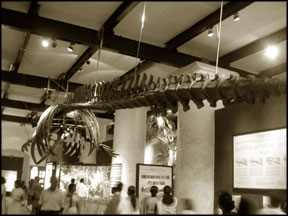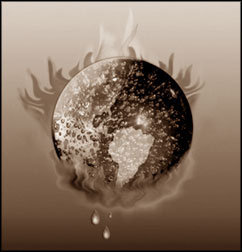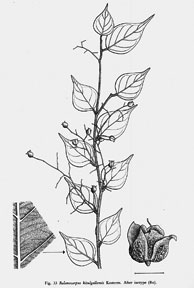Earthhope
Reflecting Southern life
Galle Maritime Museum rebuilt after tsunami:
Sajitha PREMATUNGE
As a small island nation the effects of the ocean on Sri Lankan life
is enormous. And it is never more obvious than in the Southern Coast of
Sri Lanka, being the hardest hit by the 2004 tsunami. But natural
disasters as terrorism, could not halt Sri Lanka's development process.
 |
 |
| The Dutch warehouse
where the museum is located |
The Bryde’s Whale
skeleton |
After being destroyed by the 2004 tsunami the Galle Maritime Museum
finally open to the public. The museum was originally opened on May 9,
1992, and recently reopened in a Dutch warehouse in Galle Fort. This was
a collaboration effort by the Ministry of Cultural Affairs and the
Government of the Netherlands. The renovation process was a three year
task that was funded by the Sri Lanka Netherlands Cultural Cooperation
Program. The International Museum Day was celebrated in the Museum on
May 18.
Complete with two sections - Biology and Anthropology - it is the
best place to acquire a complete understanding of the close relationship
the southern coast of Sri Lanka has had with our ocean.
The first section which is totally devoted to Anthropology, focuses
on how the ocean influenced the coastal lifestyle. "Coast dwellers
depended heavily on oceanic resources," said Director, Museums
Department, Dr. Nanda Wickramasinghe. "Consequently a whole new sub
culture with different beliefs, language and traditions is borne."
Accordingly the museum concentrates mostly on traditional fishing and
the lifestyle of coastal communities.
The Anthropology section provides information and showcases models
that depict their culture as well as several impressive models of
traditional fishing boats, the originals made of local raw material. But
the most impressive feature is probably the models of the last of the
renowned Patuwathawithana Vessels, also referred to as the `Maha Oruwa',
donated by the chief incumbent of the Dodamduwa Kumarakanda Piriwena,
Dodamduwa Dharmasena Thera. The original vessels were made completely of
local raw material. `Maha Oruwa' was the last of its kind, out of some
40 ships.
 |
 |
| The model of the
Patuwathawithana Vessel also known as ‘Maha Oruwa’ |
Egg laying model of a
Green Turtle |
The second section which is devoted to marine biology is divided in
to three galleries - Zoology, Botany and Geology. "We attempted to
include the whole of marine biology in the Zoology gallery," said Manori
Goonatilake, Assistant Director Entomology, Museums Department. It
consists of an extensive invertebrate classification, specimens of
existing species and diagrams of extinct species, including corrals,
mollusc and seven local and rare mammals.
It also exhibits different panels and showcases of common edible fish
and a large collection of shells and a collection of stuffed sea birds.
Models made of fibre glass that were salvaged from the former museum
after the tsunami is also exhibited in special tanks, to give it an
underwater effect the new museum. An egg laying model of a turtle is
also showcased using the real carapace of a Green Turtle.
The main attraction of the Zoology gallery is probably the skeleton
of a complete whale, the second such in the country, the first is of the
Blue Whale in the Colombo Museum. The skeleton was obtained from a
Bryde's Whale that beached in the Colombo harbour in 2003. Unfortunately
it was buried for five years when the Galle Maritime Museum made plans
to exhume it and salvage the skeleton in 2008. "The massive creature
would have been 13.2 metres when it was alive," said Manori Goonatilake.
The Botany gallery features vegetation in the coastal ecosystem. It
exhibits models of threatened ecosystems like mangroves and the Southern
sea shore and marine plants and algae.
 |
|
Model of a stilt fisherman in the
Anthropology gallery |
The mangrove information section includes photographs of mangrove
species, main features of the ecosystem, common plant species and
distribution.
The sea shore vegetation section also include photographs, common sea
shore plant species and sea shore plant characteristics. The Botany
gallery also exhibits a marine algae classification with photographs and
details.
The Geology gallery which consists of a panel and models on the
tsunami is the third segment of the Biology section.
The panel focuses on the factors that triggers a tsunami, how
tectonic plates converge to create an earthquake that could result in a
tsunami, the first indicator, precautions and remedial action taken for
the 2004 tsunami.
The three models demonstrate the three stages - before, during and
after the tsunami. It illustrate wave formation during the tsunami and
how height of the wave increases as it reaches shallow waters.
In addition to its exhibits the Galle Maritime Museum conducts a lot
of education programs, such as weekly seminars and as an invaluable
source of reference for school and university students. Museum
publications and leaflets can be obtained from either of the museums.
Any requests should be addressed to The Director, Nanda Wickramasinhe
or Curator, Maritime Museum D. Kandambi.
Global warming must stay below 2 C or world faces ruin
Mark HENDERSON-Science Editor
World carbon emissions must start to decline in only six years if
humanity is to stand a chance of preventing dangerous global warming, a
group of 20 Nobel prize-winning scientists, economists and writers
declared today.
The United Nations climate summit in Copenhagen in December must
agree to halve greenhouse-gas emissions by 2050 to stop temperatures
from increasing by more than 2oC (3.6F), the St James's Palace Nobel
Laureate Symposium concluded.
While even a 2oC temperature rise will have adverse consequences, a
bigger increase would create "unmanageable climate risks", according to
the St James's Palace memorandum, signed today by 20 Nobel laureates in
physics, chemistry, economics, peace and literature.
 The temperature target "can only be achieved with a peak of global
emissions of all greenhouse gases by 2015", the document said. If
emissions continue to rise after that date, the required cuts would
become unachievable. The temperature target "can only be achieved with a peak of global
emissions of all greenhouse gases by 2015", the document said. If
emissions continue to rise after that date, the required cuts would
become unachievable.
Professor Hans Joachim Schellnhuber, director of the Postdam
Institute for Climate Impact Research, a convenor of the symposium,
likened the urgency for action on climate change to the threat of
thermonuclear weapons during the Cold War.
"We are facing a crisis as deep as the arms race of the 1950s and
1960s and the Cold War notion of mutually assured destruction," he said.
"Today we have mutually assured increases in greenhouse gases."
He said the memorandum echoed a manifesto signed in 1955 when
Bertrand Russell, Albert Einstein and nine other intellectuals called
for world leaders to seek peaceful resolutions to international
conflict. "Global climate change represents a threat of similar
proportions and should be addressed in a similar manner," the memorandum
said. The extent of the climate threat is also highlighted today by a
report that suggests global warming is already killing an estimated
300,000 people per year - equivalent to the loss of life that resulted
from the 2004 Indian Ocean tsunami.
The report from the World Humanitarian Forum, an independent
organisation led by Kofi Annan, the former UN Secretary-General, claims
that 90 per cent of those deaths are related to gradual environmental
degradation resulting from the warming climate - principally
malnutrition, diarrhoea and malaria. The remaining 10 per cent are
linked with weather-related disasters.
The study, due to be presented this morning by Annan, was reviewed by
distinguished experts in the field, including Rajendra Pachauri,
chairman of the Intergovernmental Panel on Climate Change (IPCC), and
Professor Jeffrey Sachs, director of the Earth Institute at Columbia
University in New York.
It projects that by 2030, the number of annual deaths directly
resulting from the warming global climate will rise to 500,000.
The St James's Palace memorandum was agreed after three days of
discussions attended by 60 leading scientists, policymakers and
intellectuals.
Participants included Steven Chu, the US Energy Secretary and Nobel
physics laureate, Wole Solinka, the Nigerian literature laureate, and
Wangari Maathai, the first environmentalist to win the Nobel Peace
Prize.
The symposium, for which The Times was media partner, was organised
by the Potsdam Institute and the University of Cambridge Programme for
Sustainability Leadership, under the patronage of the Prince of Wales.
The memorandum called for an emergency package of financial support
for tropical forest nations, as the loss of forests is responsible for
about 18 percent of global carbon emissions.
"The St. James's Palace memorandum calls for a global deal on climate
change that matches the scale and urgency of the human, ecological and
economic crises facing the world today," the final document said.
"It urges governments at all levels, as well as the scientific
community, to join with business and civil society to seize hold of this
historic opportunity to transform our carbon-intensive economies into
sustainable and equitable systems. We must recognise the fierce urgency
of now."
(Timesonline)
Your planet needs you
Dhaneshi YATAWARA
 Focusing on the climate changes and related broader consequences of
environmental changes the World Environment Day (WED) for 2009 falls on
5th June. Under the theme `Your planet needs you! Unite to combat
climate change' focus will be more on educating the public more on the
responsibilities of the societies. Focusing on the climate changes and related broader consequences of
environmental changes the World Environment Day (WED) for 2009 falls on
5th June. Under the theme `Your planet needs you! Unite to combat
climate change' focus will be more on educating the public more on the
responsibilities of the societies.
Mexico will hold the international celebrations of the World
Environment Day drawing attention to some of the impacts on environment
from human activities. It highlights the urgent need to change attitudes
and behaviour of the world communities and inspire political and
community action.
The official event of the national celebrations will be held on June
5 at 10 a.m. at the Vihara Maha Devi Park in Colombo, Ministry of
Environment informs.Prime Minister Rathnasiri Wickramanayake will be the
chief guest at the national event. On the same day, an islandwide school
program is also scheduled. The National Environmental Photography
exhibition organised by the Central Environment Authority will be opened
for the public on June 4 at 9 a.m. at the National Arts Gallery. The
exhibition will be open till June 6. The National Environment Exhibition
organised by the Environment Ministry, will be held at the Vihara Maha
Devi Park in Colombo from June 4 to 6.
A special workshop on bio-diversity will be held on June 4 at 2 p.m.
where the Ministry will also hold an event appreciating contribution of
the Environmental Journalists. Under the Ministry, special programs will
be launched to increase awareness on environment conservation.
Nearly extinct?
Source: (Kostermans, 1992)
Family: Dipterocarpaceae
Scientific Name: Balanocarpus
kit ulgallensis Kosterm.
Status: Critically Endangered, Endemic
 Balanocarpus kitulgallensis belongs to Dipterocarpaceae family (Hora
family) which consists of fifty eight species, all of which are
restricted endemic. Genus Balanocarpus consists of two species among
them B.kitulgallensis is only recorded from the Kitulgala area. Balanocarpus kitulgallensis belongs to Dipterocarpaceae family (Hora
family) which consists of fifty eight species, all of which are
restricted endemic. Genus Balanocarpus consists of two species among
them B.kitulgallensis is only recorded from the Kitulgala area.
It is a tree of medium size about 6m in height. The bark of the tree
is thin, smooth the light brown in colour. Branches are slender, hanging
medium in a loose arrangement with dense hairs.
Identification features are, small leaves with 3 (rarely 4) pairs of
lateral nerves and a little network structure and typical horizontal,
parallel secondary veins, few much smaller flowers along branches,
fruits almost directly attached to the stem and elongate-ovoid in shape.
According to the 2007 Red List of Threatened Fauna and Flora of Sri
Lanka B. kitulgallensis is critically endangered species. This species
may go extinct in the future due depletion of forest (especially tea
cultivation), logging, habitat destruction, etc...
References:
1. Kostermans, A.J.G.H. (1992) A handbook of the Dipterocarpaceae of
Sri Lanka. Wildlife Heritage Trust of Sri Lanka.
2. IUCN Sri Lanka and the Ministry of Environment and Natural
Resources (2007) The 2007 Red List of Threatened Fauna and Flora of Sri
Lanka, Colombo, Sri Lanka.
By Dilup Chandranimal
IUCN (The International Union
for Nature Conservation of Nature)
Sri Lanka-Country Office
|

